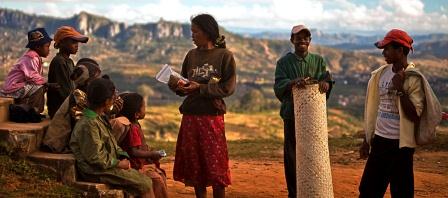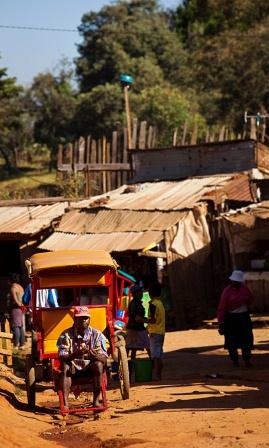Bug-Eyed Over Lemurs!
Conservation — Key to Survival
Kasey-Dee Gardner
 Most Malagasy people live on less than $1.25 a day. Even for someone accustomed to roadside shacks and malnourished babies, it’s never comfortable seeing these images playing out over and over again as we drive through the country.
Most Malagasy people live on less than $1.25 a day. Even for someone accustomed to roadside shacks and malnourished babies, it’s never comfortable seeing these images playing out over and over again as we drive through the country.
Early on in our trip, our driver Tov pulled off on the side of the road for a rest break. At the stop, a mother and her seven children were huddled on the side of the road. Their clothes were worn, their faces covered in dirt. I doubt they’d eaten in the last couple of days. I had some crackers, NutriGrain bars, and Cliff Bars in my suitcase. The moment I pulled them out, the kids grabbed them out of my hands so fast. Most of us don’t realize what it is like to be that hungry.
 During the last two weeks, we’ve traveled from Central Madagascar to Southern Madagascar to the Northeast. We’ve spent many of those days on the road and Dan and I have gotten to know our driver Tov quite well. Like Dan and me, he’s also in his late 20’s and in a similar place in life where work is his top priority. Tov’s a good looking guy, well dressed by any standards (especially Malagasy standards where most people wear hand-me-downs and second-hand clothes).
During the last two weeks, we’ve traveled from Central Madagascar to Southern Madagascar to the Northeast. We’ve spent many of those days on the road and Dan and I have gotten to know our driver Tov quite well. Like Dan and me, he’s also in his late 20’s and in a similar place in life where work is his top priority. Tov’s a good looking guy, well dressed by any standards (especially Malagasy standards where most people wear hand-me-downs and second-hand clothes).
Tov drives tourists all over Madagascar, and his days are at least twelve hours long. During one of our conversations, he told me that he earns $5 a day as a driver. That’s how much a sandwich costs in the United States. But considering most Malagasy live on about a dollar a day, his salary is above average. Even so, I have no idea how someone lives on that income.
Tov’s salary explains why people in Madagascar chop down the forests, hunt lemurs, and mine the land. They don’t have a lot of options. But conserving the forests and the land is vital, because once Madagascar loses the remaining 15 percent of viable land, there’ll be nothing left and survival will even pose a bigger challenge.
Photos: Dan Plimpton
